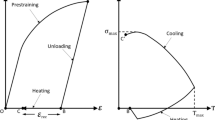Abstract
Concrete girders can suffer from serviceability issues due to excessive cracking and deflection. In response to this problem, a novel heat-induced post-tensioning technique utilizing unbonded near-surface mounted nickel–titanium–niobium (NiTiNb) shape-memory alloy (SMA) wires was proposed and evaluated. SMAs are a class of smart materials that can recover seemingly permanent plastic deformation when heated. The post-tensioning forces, thus, can be generated by restrained heat-induced shape recovery of SMA wires. Material characterization tests showed that 3.92-mm diameter NiTiNb wires with 2.5% prestrain can generate recovery stress of approximately 500 MPa when actuated via Ohmic heating in a restrained condition. The proposed post-tensioning system was experimentally evaluated in reinforced concrete girders measuring 2.3 m in length and 23 × 41 cm in cross-sectional dimensions. The girders were initially cracked to simulate typical girder damage. NiTiNb wires were then installed in the bottom cover of the girders and anchored at both ends. Subsequently, the wires were actuated via Ohmic heating, which triggered shape-recovery and generated post-tensioning stresses in the girder. The post-tensioning technique reduced the crack widths by up to 74% (370 μm) and recovered the residual midspan deflection by up to 49% (1.52 mm) in the cracked girders. Following post-tensioning, flexural loading up to failure showed that the cracked stiffness and ultimate moment capacity of the girders had increased by up to 31% and 45%, respectively, with a relatively small NiTiNb reinforcement ratio of up to 0.17%.

Reused with permission from [3]












Similar content being viewed by others
References
Cairns J, Rafeeqi SFA (2003) Strengthening reinforced concrete beams with external unbonded bars: experimental investigation. Proc Inst Civil Eng Struct Build 156(1):27–37
El-Hacha R, Soudki K (2013) Prestressed near-surface mounted fibre reinforced polymer reinforcement for concrete structures—a review. Can J Civ Eng 40(11):1127–1139
Lagoudas DC (2008) Shape memory alloys: modeling and engineering applications. Springer, Berlin
Soroushian P, Ostowari K, Nossoni A, Chowdhury H (2001) Repair and strengthening of concrete structures through application of corrective posttensioning forces with shape memory alloys. Transp Res Rec J Transp Res Board 1770:20–26
Deng Z, Li Q, Sun H (2006) Behavior of concrete beam with embedded shape memory alloy wires. Eng Struct 28(12):1691–1697
Li H, Liu Z, Ou J (2006) Behavior of a simple concrete beam driven by shape memory alloy wires. Smart Mater Struct 15(4):1039
Ozbulut OE, Hamilton RF, Sherif MM, Lanba A (2015) Feasibility of self-pre-stressing concrete members using shape memory alloys. J Intell Mater Syst Struct 26(18):2500–2514
Czaderski C, Shahverdi M, Brönnimann R, Leinenbach C, Motavalli M (2014) Feasibility of iron-based shape memory alloy strips for prestressed strengthening of concrete structures. Constr Build Mater 56:94–105
Shahverdi M, Czaderski C, Motavalli M (2016) Iron-based shape memory alloys for prestressed near-surface mounted strengthening of reinforced concrete beams. Constr Build Mater 112:28–38
Shahverdi M, Czaderski C, Annen P, Motavalli M (2016) Strengthening of RC beams by iron-based shape memory alloy bars embedded in a shotcrete layer. Eng Struct 117:263–273
El-Hacha R, Rojob H (2018) Flexural strengthening of large-scale reinforced concrete beams using near-surface-mounted self-prestressed iron-based shape-memory alloy strips. PCI J 63(6):51–62
Shahverdi M, Michels J, Czaderski C, Motavalli M (2018) Iron-based shape memory alloy strips for strengthening RC members: material behavior and characterization. Constr Build Mater 173:586–599
Dommer K, Andrawes B (2012) Thermomechanical characterization of NiTiNb shape memory alloy for concrete active confinement applications. J Mater Civ Eng 24(10):1274–1282
Zhao H, Andrawes B (2017) Mechanical properties of NiTiNb shape memory alloy subjected to a harsh corrosive environment. J Mater Civ Eng 29(3):04016232
ASTM C39/C39M-18. Standard test method for compressive strength of cylindrical concrete specimens, West Conshohocken, PA
ACI 318-14 (2014) Building code requirements for structural concrete and commentary, ACI Committee 318. Farmington Hills, MI
Shin M, Andrawes B (2010) Experimental investigation of actively confined concrete using shape memory alloys. Eng Struct 32(3):656–664
ACI 224R-01 (2001) Control of cracking in concrete structures. ACI Committee 224, Farmington Hills, MI
Acknowledgements
The authors gratefully acknowledge financial support from the Louisiana Transportation Research Center (Award No. 18-2TIRE) and the University of Delaware internal funds.
Author information
Authors and Affiliations
Contributions
Jovan Tatar and Nikola Tatar contributed to the study conception and design. Specimen preparation, data collection and analysis were performed by Arkabrata Sinha and Jovan Tatar. The first draft of the manuscript was written by Arkabrata Sinha and Jovan Tatar, and all authors commented and edited previous versions of the manuscript. All authors read and approved the final manuscript.
Corresponding author
Ethics declarations
Conflict of interest
The authors declare that they have no conflict of interest.
Additional information
Publisher's Note
Springer Nature remains neutral with regard to jurisdictional claims in published maps and institutional affiliations.
Rights and permissions
About this article
Cite this article
Sinha, A., Tatar, N. & Tatar, J. Rapid heat-activated post-tensioning of damaged reinforced concrete girders with unbonded near-surface mounted (NSM) NiTiNb shape-memory alloy wires. Mater Struct 53, 88 (2020). https://doi.org/10.1617/s11527-020-01522-8
Received:
Accepted:
Published:
DOI: https://doi.org/10.1617/s11527-020-01522-8




